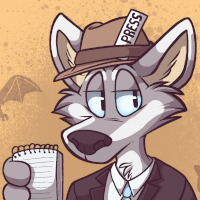The Book of Lapism, by Phil Geusz (2nd enlarged edition) – review by Fred Patten.
by Patch O'Furr
Submitted by Fred Patten, Furry’s favorite historian and reviewer.
The Book of Lapism, by Phil Geusz. [2nd enlarged edition.]
Birmingham, AL, Legion Printing & Publishing, January 2015, hardcover $24.99 (351 [+1] pages), Kindle $4.99.
 This book is a bibliographer’s nightmare. It’s referred to as the Deluxe edition, the 2nd printing (but presumably means the first printing of the second edition), and as The New Book of Lapism. Fortunately, it’s easily distinguishable from the first edition (Anthro Press, June 2009). That had a different cover (this one is by Micheal Day), was a trade paperback, and had two less stories.
This book is a bibliographer’s nightmare. It’s referred to as the Deluxe edition, the 2nd printing (but presumably means the first printing of the second edition), and as The New Book of Lapism. Fortunately, it’s easily distinguishable from the first edition (Anthro Press, June 2009). That had a different cover (this one is by Micheal Day), was a trade paperback, and had two less stories.
This new hardcover is truly impressive, in thick, high-quality boards and a 8.5” X 11” giant size with large, easily read type. Still, almost all the sales are likely to be of the more affordable and easily held Kindle edition. It’s well worth getting in either case. The first edition is out of print, and lacks the two most recent stories. This new edition is complete.
Phil Geusz’s Lapist stories are set in the unspecified near future, maybe a hundred years from now, when materialism, greed, and a callous fuck-you-Jack;-I’ve-got-mine society are making more thoughtful people despondent about whether there is anything worth living for. The philosophy/religion of Lapism grows up; a true brotherhood whose adherents have themselves physically bioengineered into anthropomorphic rabbits to show their friendly, gentle, caring nature. The Lapists have a very rocky and insecure first few years, as covered in these six stories.
More rocky than they’d probably like to admit. There are serpents in Paradise.




![AC01--Who_Killed_Kathleen_Gingers_[cover] (1)](https://i0.wp.com/dogpatch.press/wp-content/uploads/2015/05/ac01-who_killed_kathleen_gingers_cover-1.jpg?resize=350%2C544)





